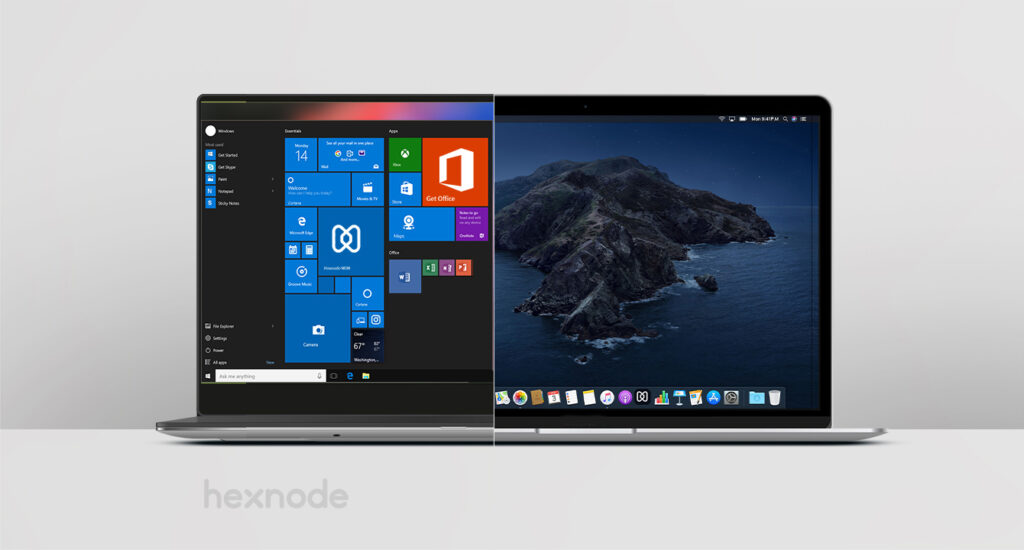What’s a Spotify playlist without Rihanna in it? How about a Riverdale series without Jughead? What’s a juice box without juice in it? What’s a Mac without any apps? These questions tip to the side of annoying, don’t they? Well, of course, they are! Everyone knows that there ain’t no Spotify playlist without Rihana. Jughead is the heart of Riverdale. The juice box is meant to hold juice. But most importantly, applications or apps, as we know them, are the heart and soul of any mobile device.
Importance of app management:
Before jumping straight to app distribution in Mac, their management and how Hexnode factors, let’s answer some of the basics. A rising variety of applications are used by small and medium-sized organizations to promote teamwork, worker productivity, and company expansion. Business apps offer incalculable benefits, but they also need constant monitoring to function at their best. The administrative work required when your business grows and starts utilizing more and more applications can be taxing on your internal resources. This is exactly why app management is necessary for any organization deploying mobile devices to its workforce to access sensitive company data.
Also…
Despite the hype about mobile devices, the focus is all really on the apps. Mobile productivity and efficiency are driven by mobile apps and the data they access. Today’s tech-savvy workforce doesn’t sit around waiting for IT to provide them with mobile apps either. To execute their jobs as effectively as possible, employees increasingly use any apps they choose for file synchronization and sharing, note-taking, communication, and other tasks. 25% of workers worldwide, according to Forrester, bring their own mobile apps to fill in for any apps that are lacking from their work environments. Imagine the kind of nightmare the IT admins will have if one of these apps ends up leaking corporate data. A really bad nightmare indeed!
So, you see, application management really is something the IT team has to tackle.
Hexnode to the rescue:
All right, this one is for the admins who would like to know how Hexnode manages the apps on the Macs deployed in the organizations that use Hexnode as their Unified Endpoint Management (UEM) solution. Never before has Mac app distribution been easier!
Trick 1 – Mandating apps as part of app distribution in Mac:
There’s always a set of applications without which an organization can’t function. Be it Microsoft Teams for collaborative calls from across the world or VS code for all the developers, junior-senior alike, or even the Adobe illustrator app for all the designers in the organization, all the employees in the respective teams need these apps to function. So, wouldn’t it be easier for the IT team to just wave their magic wands and have all the Macs install these apps?
Well, there is no magic wand, but with Hexnode, the admins can push a policy mandating the necessary apps. And just like that, the apps with the correct version and all will be installed on the Macs. All of this with zero interference from the user’s end. With the policy in place, there is no getting rid of the app, even if they try to remove it. Well, isn’t that just wonderful!
Trick 2 – Blacklisting/Whitelisting apps:
What’s the one goal that any company or organization wants to push its employees to? Yup, that’s right. Higher productivity combined with better efficiency. What if some apps distract the employees or at least are malicious enough to corrupt the system and leak sensitive information. Wouldn’t it be a part of app management to handle this problem? Of course, it is! Hexnode allows the admins to blacklist or whitelist applications on the Mac. Technically, blacklisting and whitelisting work conversely. Blacklisting allows admins to block access to certain apps. The policy blocks any attempt made to access the blacklisted apps. The whitelisting policy allows access only to the whitelisted apps, effectively blacklisting the other apps.
Trick 3 – Creating an app catalog:
One way that Hexnode allows to effectively provision the Macs deployed across the organization is the app catalog policy. A company might need a safe way to house all of its essential applications in one place. Administrators can build a specific app store with a selection of apps that can satisfy an organization’s needs using Hexnode’s “App catalog” function. The policy allows the admins to create a customized app store on the user’s end. End users may easily download all the necessary apps from the app store, avoiding the risk of them running the wrong ones. Businesses may quickly get their users up and running with all the authorized business apps by doing this. The Hexnode app installed on the Macs during enrollment houses the app catalog.
Trick 4 – App configurations – adding on to the experience of Mac app distribution:
Admins can remotely tweak a few app settings to meet the company’s requirements. What settings, you ask? Well, settings like accounts, logins, etc. Configuration files help apply these configurations. Admins deploy these configuration files in XML format. However, the configurations can only be applied to the apps that are provisioned for it. Application configurations allow the admins to enable a user to use the applications right after the configured apps are distributed to the Mac. Indeed, this is a nifty and handy trick for app distribution on a Mac!
Trick 5 – Tweaking the settings for Kernel extensions and System extensions:
All the app developers and computer geeks out there who’ve been hunched up in front of their Mac screens trying to tweak around and better their app experiences, know all about kernel and system extensions. But of course, for those who don’t, let’s shine some light on what these extensions mean! In the simplest of terms, these extensions allow the apps to extend the capabilities of macOS in a way that normal apps cannot. But then, what is the difference between system extensions and kernel extensions? Technically, system extensions are a better fix for developing apps with advanced functionalities in comparison with kernel extensions. Simply because they allow the users to create the same apps with advanced functionalities but without providing kernel access. How does not giving kernel access make them better? Easy, no kernel access means a lesser threat to the stability and security of Mac.
Admins can easily use Hexnode to create a list of kernel extensions that can be loaded without user interference. For system extensions, admins can ensure the successful activation of extensions all the while ensuring that the removal of the policy also removes all the applied extensions.
On another note…
These policies aside Hexnode has other ways to manage the apps on your Macs. The UEM solution allows IT admins to place several restrictions on the usage of certain apps and the app store. Admins can restrict the sources to install apps on Macs. Conveniently, the Hexnode dashboard provides detailed input about the apps installed on the managed apps. Admins can also remotely install an app on the Mac without disturbing the employees working on the Mac. Not to forget, Hexnode also provides for remotely enforcing OS updates on the managed Macs, thus keeping them updated to the latest OS.
Summing it up:
Everything from the policies to the remote actions is all part of the grand scheme which is application management. Essential for protecting corporate data as well as improving employee productivity and efficiency, app management is indeed a very crucial part of device management in the modern corporate environment. Today’s mobile corporate environment demands a holistic approach toward security and management. Beyond controlling devices, a thorough mobile strategy also includes information and app protection. Don’t forget to invest in a dynamic UEM solution to secure your organization’s data with the most all-around and holistic approach possible.
Start your free trial today!
Start your 14-day free trial to get a taste of Hexnode's app management capabilities for all your Macs.
Sign up now





